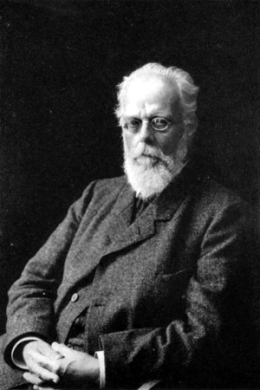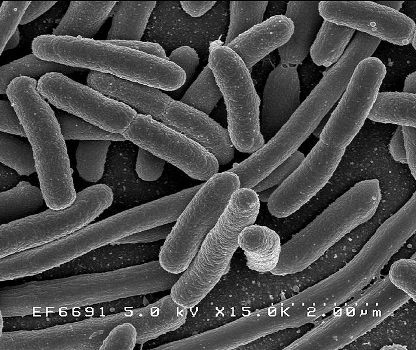Mathilde Ludendorff on the natural death of multicellular organisms and potential immortality of single-celled organisms

It seems to me that Mathilde Ludendorff posited that there is some kind of immortality in certain kinds of unicellular organisms and germ cells, but that death in multicellular organisms is some step in becoming with the divine. This article discusses these topics further and whether Ludendorff had some biological misconceptions held in her age.
https://ludendorff.info/natuerlicher-tod-von-vielzellern-und-potentielle-unsterblichkeit-von-einzellern/
What is the meaning of death? Why are single-celled organisms immortal and why do multicellular organisms have to die? Mathilde Ludendorff raises such questions in her work "Triumph of the Will to Immortality. But do their assumptions still correspond to the current state of scientific knowledge?
 "Triumph of the Will to Immortality" (1) is the title of the first and fundamental work of the philosopher Mathilde Ludendorff. The will to immortality triumphs. What does he triumph over? About the inevitable death, the need to die, or as one can also say: about the need to die. Colloquially, one often speaks of a triumph when a development went in an "unwanted" direction and then suddenly and unexpectedly took a "good" turn. In the case of Mathilde Ludendorf's triumph of the will to immortality, this means that the first single-celled organisms were potentially immortal. For them, death is not necessarily victorious, but only triumphs in the event of an accident or other kind of injury. That is why we only speak of potential immortality. However, the multicellular organisms that evolved from the single-celled organisms must inevitably die after a specified period of time for each species. How, then, can it be said that the will to immortality ultimately triumphs in man? He triumphs in a spiritualized way with man, the only living being who can consciously experience the Divine before his death. The Divine is beyond space, time and causality. This means that man can consciously experience a timelessness, one could also say "eternity" and thus fulfill his longing for immortality. His will to immortality triumphs! In a few words, this is one of the core statements from Mathilde Ludendorff's first work.
"Triumph of the Will to Immortality" (1) is the title of the first and fundamental work of the philosopher Mathilde Ludendorff. The will to immortality triumphs. What does he triumph over? About the inevitable death, the need to die, or as one can also say: about the need to die. Colloquially, one often speaks of a triumph when a development went in an "unwanted" direction and then suddenly and unexpectedly took a "good" turn. In the case of Mathilde Ludendorf's triumph of the will to immortality, this means that the first single-celled organisms were potentially immortal. For them, death is not necessarily victorious, but only triumphs in the event of an accident or other kind of injury. That is why we only speak of potential immortality. However, the multicellular organisms that evolved from the single-celled organisms must inevitably die after a specified period of time for each species. How, then, can it be said that the will to immortality ultimately triumphs in man? He triumphs in a spiritualized way with man, the only living being who can consciously experience the Divine before his death. The Divine is beyond space, time and causality. This means that man can consciously experience a timelessness, one could also say "eternity" and thus fulfill his longing for immortality. His will to immortality triumphs! In a few words, this is one of the core statements from Mathilde Ludendorff's first work.
The assumption of a potential immortality of single-celled organisms goes back to August Weisman (1834 to 1914). Weismann was one of the most important evolutionary theorists of the 19th century and is considered the founder of neo-Darwinism, the further development of Darwin's theory of evolution. A core statement by August Weismann, which is also quoted in The Triumph of the Will to Immortality, reads (1, p. 122): "My sentence about the potential immortality of the single-celled organisms is intended to do nothing more than to make science aware that between single-celled and multicellular organisms lies the introduction of physiological, i.e., normal, death, and this truth will not be overturned by any sophisms." From the last words it is easy to deduce that the proposition about the immortality of single-celled organisms was very controversial at that time. Weismann also showed that in multicellular organisms, the somatic cells (the somatic cells or soma) are subject to inevitable death, while the germ cells remain potentially immortal and form the so-called germline from generation to generation. Mathilde Ludendorff listened to Weismann's lectures during her studies in Freiburg and shared the evolutionary biologist's view that single-celled organisms are potentially immortal, but she rejected the reasons he gave for the death of multicellular organisms (see below).

In several works, the philosopher discusses in detail the scientific theories of the time on the aging and death of living beings. Particularly detailed in the first volume of "Miracles of Biology in the Light of the Knowledge of God in My Works." (2) The following passage is also taken from this work, which contains further important statements by Mathilde Ludendorff on our subject: "In the death of the higher living beings and its deep contradiction to the will to self-preservation (...) There was a strong motive force for the change of perfecting the defense against the danger of death, which revealed its deep meaning only after attaining consciousness. I have shown that consciousness enables man to participate in the beyond of time and space, which he calls "eternity" or "God," in the experience of his own soul before death. The "story of creation", however, then allowed us to see death as a wonderful ability of living beings that makes sense for the divine. For only after the possibility of death of the lowest living beings had become the reliable death of the higher living beings through accident, did a conscious experience of the divine become possible in an individual being of the universe, because it was compatible with divine perfection." (2, p. 199 f).
(...)
Now the Triumph was published in 1922, the Creation Story in 1923 and Wonders of Biology in 1950. In view of the enormous increase in knowledge, especially in the life sciences, this corresponds to "half an eternity". Therefore, the question arises: What endures, what may have proven to be erroneous?

In 2005, a group of French researchers published study results on the ageing of bacteria (3). These have also caused a stir in the popular science press. For example, in "Spektrum der Wissenschaft" (4) it was said: "No one is immortal. Until now, only single-celled microbes have been considered an exception, because they simply divide to multiply, so that the mother cell merges into the two daughters and thus continues to live seemingly indefinitely." According to the new evidence presented, "eternal life is really not granted to anyone, not even bacteria." The French researchers showed that during the division of the bacterium Escherichia coli (E. coli), those daughter cells that predominantly take over old cell components from the mother cell are less vital, divide less frequently and are more likely to die than those daughter cells that predominantly form new structures. The researchers therefore conclude that no life form is immune to aging. So it is indeed time to put Mathilde Ludendorff's statements to the test.
(...)

According to the presentation of the current research results, the following conclusion can be drawn: So far, no single-celled species is known in which every cell without exception would be subject to a genetically pre-programmed death of old age. The death of some daughter cells associated with asymmetric division does not change the fact that the hereditary daughter cells and their offspring that are not affected by it are potentially immortal.
However, it is not entirely correct to say that every single single-celled organism is potentially immortal and that all multicellular organisms without exception are subject to death. Rather, it is true that there are daughter cells of single-celled organisms that have to die. It is also true that there are a few simple multicellular organisms that are immortal, while higher multicellular organisms are invariably subject to the need to die. Consequently, the claim of the French researchers that no life form is immune to aging is correct insofar as there are not only multicellular organisms but also single-celled organisms that cannot live forever. However, their statement does not mean that this is true for all single-celled organisms or for all multicellular organisms.
The statement of August Weismann and Mathilde Ludendorff, according to which the origin of the first true multicellular organisms, i.e. the separation of germline and soma, was associated with the death compulsion, is still valid in principle according to the current state of knowledge, although not in the exclusivity as it is sometimes formulated.
Furthermore, it should be noted that the existence of a natural death, i.e. a death that inevitably occurs and does not occur due to wear and tear, is no longer disputed today, as it was in Mathilde Ludendorff's time. The philosopher's statement holds true here as well. Death is part of the normal genetic development program.
The zoologists Gehring and Wehner summarize these findings in their textbook with the following words (13): "With the separation of germline and soma, the natural death of the individual was established as a biological phenomenon during the transition from single-celled organisms to multicellular organisms. The soma is left behind as a corpse, and only the cells of the germline live on in the next generation. In the case of simple metazoans alone... there are still totipotent somatic stem cells ... that can regenerate a new animal. Higher metazoans have a limited lifespan, which depends on environmental conditions, but whose framework is genetically determined."
This was, so to speak, the final word from a scientific point of view. The last word from a philosophical point of view belongs to Mathilde Ludendorff (from the story of creation, 22, p. 38):
"But God-consciousness causes transience of the soul,
Then, enlightened by the goal of creation, transient cells became in the individual."
For the first time, a living being
now showed lawfully limited dwelling in appearance, reliably granted transience of its body,
and thus the reliable passing away of the soul forever.
When the body has shown its vitality for a measured period of time,
it withers away in death, its transient soul disappears,
living matter becomes living matter from the previously living being!
The path to God-wakefulness is now wide open in this creation,
conscious divine life becomes compatible with the majesty of God. (...)"
Sources:
Grampp, Karl (2010): "The Immortality of Single-Celled Organisms: An Outdated Assumption?". Mensch und Maß, 14/2010: 625-644.
Pictures
| Featured image | By Dr. Eugen Lehle – Own work http://bodenlabor.de, CC BY-SA 3.0, Link |
| Fig. 01 | By Unknown – Edwin G. Conklin, "August Weismann" Proceedings of the American Philosophical Society, Vol. 54, No. 220 (Oct. – Dec., 1915), pp. III-xii., Public Domain, Link |
| Fig. 02 | By Credit: Rocky Mountain Laboratories, NIAID, NIH – NIAID: These high-resolution (300 dpi) images may be downloaded directly from this site. All the images, except specified ones from the World Health Organization (WHO), are in the public domain. For the public domain images, there is no copyright, no permission required, and no charge for their use., Public Domain, Link |
| Fig. 03 | By Barfooz at the English Wikipedia. – Originally uploaded to the English Wikipedia, where it was made by Barfooz., CC BY-SA 3.0, Link |



Comments
Post a Comment